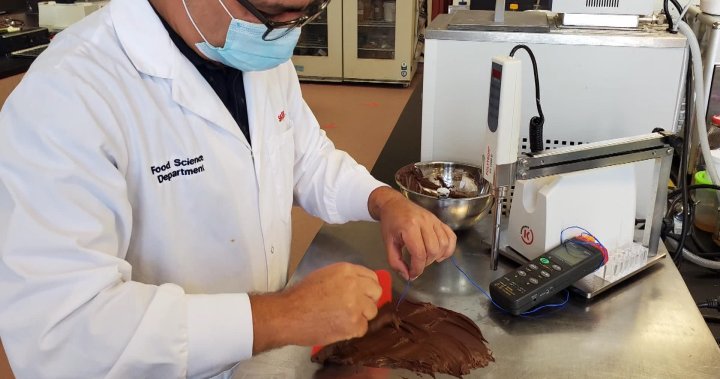A University of Guelph professor is hoping to take the mystery out of chocolate-making so people can make good-quality chocolate at home.
Alejandro Marangoni says a major problem in chocolate-making is tempering — the art of manipulating cocoa butter into the correct gloss.
“If you don’t do it carefully, you can make a disaster,” Marangoni said.
“Maybe you’ve tried to make some good-eating quality chocolate and (it) ended up looking either whitish or too soft, or melted in the hands and not in the mouth.”
Marangoni wondered if adding a special ingredient to chocolate could drive the formation of the correct crystal structure without the complex cooling and mixing procedures typically used by chocolatiers during tempering.
“Imagine if you could add a component that directs the entire crystallization process to a high-quality finished product,” he said.
“You wouldn’t need fancy tempering protocols or industrial machines — you could easily achieve the desired crystalline form just by the addition of this component.”
Marangoni’s team turned to the Canadian Light Source in Saskatoon to see if their special ingredient — a specific phospholipid — could drive the formations of an ideal chocolate structure.
The CLS’s light beam allowed the team to get images of the interior structure of their dark chocolate, which Marangoni called “beautiful.”
“That was really the first time that anybody had imaged chocolate in that way, and it provided some amazing views,” Marangoni said.
“(It) determined that the crystal density, the fat crystal density in the well-tempered chocolate, as well as the chocolate that contains our ingredient as a comparison, was the same and we had actually achieved that goal.”
The results could drive the way chocolate is made.
Marangoni said complex tempering machines would no longer be needed and that could open possibilities for smaller manufacturers to produce chocolate.
“I think small and medium chocolatiers will benefit. They’re not bottlenecked by trying to temper chocolate in two-kilogram quantities, one at a time, every time they want to produce a chocolate product,” he said.
“And maybe for the large guy, this would be like an insurance policy that you always get the right crystal formula microstructure.”
Marangoni noted that chocolate research pales in comparison to other issues the world is facing, but said food does have an impact on everyday lives.
“We have more serious problems like climate change and alternative energies and maybe even vegan foods, which we’re working on as well, but chocolate gives us that psychological pleasure,” he said.
“It’s one of these foods that makes us feel happy.”
© 2021 Global News, a division of Corus Entertainment Inc.






More Stories
‘Pretty scary’: Ill Ontario man stranded in Costa Rica finally recovering in Canada | Globalnews.ca
Trump allies Meadows, Giuliani among 18 indicted in Arizona election interference case | CBC News
RCMP confirm 2 kayakers missing from Sidney, B.C., found dead in Washington state | CBC News